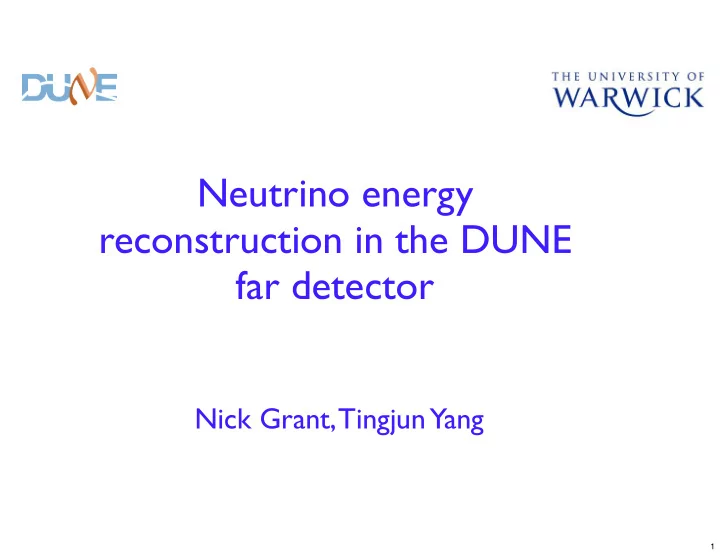

Neutrino energy reconstruction in the DUNE far detector Nick Grant, Tingjun Yang 1
Updates Will show updates for ν μ CC events with contained tracks. Looked at bias of reco energy as a function of true energy. Also looked at low tails in plots of track momentum resolution. 2
Updates Initially tried to use the same method that worked to correct bias as function of true energy for ν e CC events: add one more bin to correction of reco hadronic energy at low true hadronic energy, then adjust fit ranges to obtain a better fit in lowest true hadronic energy bins. Unfortunately this gave no improvement. Realised that the method works for ν e CC events since there is almost no bias in reco shower energy compared with true electron energy. It does not work for ν μ CC events as there are noticeable biases in reco track momentum compared with true muon momentum for both contained and exiting tracks. 3
Track momentum resolution by range Investigate low tails by plotting resolution of momentum by range against ratio of momentum by range / MCS momentum True CC events with contained track Pandora PMTrack Please see also slide 11 in https://indico.fnal.gov/getFile.py/access?contribId=5&resId=0&materialId=slides&confId=13342 4
Track momentum resolution by range Tracks in low tails of momentum by range resolution tend to have low values of ratio of momentum by range / MCS momentum (previous slide). Use MCS momentum as a cross check of reconstruction of range. In low tails, MCS momentum would be more accurate than momentum by range even though these tracks are contained. Use MCS instead of momentum by range if ratio < 0.7. This does give some reduction in the low tails (next slide). Unfortunately, however, the effectiveness of this is reduced since some of the tracks in the low tails have reconstructed length < 100 cm. For these short tracks, it is not possible to split them into enough segments to calculate the MCS momentum. 5
Track momentum resolution by range True CC events with PMTrack Pandora contained track Use range for all tracks Use range if range / MCS > 0.7; otherwise use MCS 6
Track momentum resolution by range Now try to improve track momentum resolution. Experiment with changing binning of calibration of track momentum by range using true muon momentum. 7
Track momentum resolution by range True CC events with PMTrack Pandora contained track For calibration use 5 bins of true momentum from 0.5-3.0 GeV (width 0.5 GeV). For calibration use 5 bins of true momentum from 0.2-1.7 GeV (width 0.3 GeV). Also double numbers of bins in resolution plots. 8
Track momentum resolution by range Following this change of binning, there is a clear reduction in both the bias and the width of the resolution of track momentum by range. For PMTrack, the bias is reduced from 0.05 to 0.01 and the width from 0.06 to 0.04. For Pandora, the bias is reduced from 0.08 to 0.02 and the width from 0.08 to 0.05. 9
Track momentum resolution by range PMTrack Now try to remove remaining small biases in resolution of track momentum by range. 1. In calibration plots, tried using mean of true momentum distribution within each bin instead of centre of bin - this made no real difference. 2. In calibration plots, tried reversing axes Pandora and plotting true muon momentum in bins of reconstructed length - this gave a similar bias with a slightly larger width. 3. Try making ad hoc tweaks of gradients and intercepts of calibration plots - this gives some improvement (next 2 slides). 10
Track momentum resolution by range True CC events with PMTrack contained track Gradient = 433 Intercept = -49 (as in calibration plot) Keep gradient = 433, make ad hoc tweak of intercept to -54. This corrects bias. 11
Track momentum resolution by range True CC events with Pandora contained track Gradient = 422 Intercept = -44 (as in calibration plot) Keep intercept = -44, make ad hoc tweak of gradient to 432. This corrects bias and reduces width. 12
ν μ energy resolution Now check the effect of the improvement in resolution and bias of track momentum by range on ν μ energy resolution as a function of true ν μ energy for ν μ CC events with contained tracks. 13
ν μ energy resolution True CC events with PMTrack Pandora contained track Before improvement of resolution of track momentum by range After improvement of resolution of track momentum by range No real improvement in bias of ν μ energy resolution 14
ν μ energy resolution PMTrack True CC events with contained track Now try ad hoc tweaks of gradient and intercept of Gradient = 0.61 correction of reco hadronic Intercept = 0.07 energy (bottom left plot). (as in correction Use improved reco track plot) momentum but without ad hoc tweaks. Make ad hoc tweaks to gradient = 0.68, intercept = 0.14. This corrects bias. (Caveat: might need to retune for other datasets.) 15
ν μ energy resolution Pandora True CC events with contained track Now try ad hoc tweaks of gradient and intercept of correction of reco hadronic Gradient = 0.60 energy (bottom left plot). Intercept = 0.00 Use improved reco track (as in correction momentum but without ad plot) hoc tweaks. Make ad hoc tweaks to gradient = 0.68, intercept = 0.025 This corrects bias. (Caveat: might need to retune for other datasets.) 16
ν μ energy resolution True CC events with contained track With improvement of track momentum resolution, limiting factor in ν μ energy resolution is the hadronic energy. Resolution of this is worse at low true hadronic energy. PMTrack Pandora 17
BACKUP SLIDES 18
Recommend
More recommend